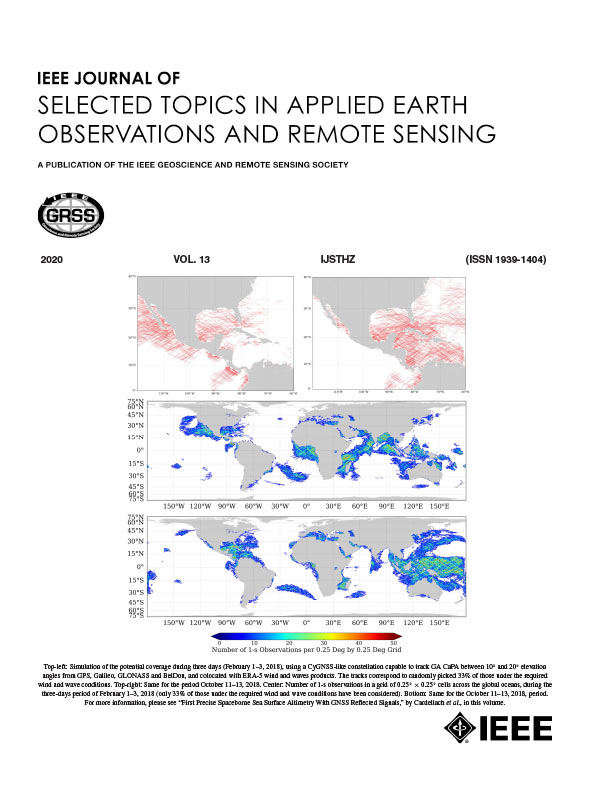基于部分连体网络的合成孔径雷达干涉测量相位非本地滤波器
IF 4.7
2区 地球科学
Q1 ENGINEERING, ELECTRICAL & ELECTRONIC
IEEE Journal of Selected Topics in Applied Earth Observations and Remote Sensing
Pub Date : 2024-09-10
DOI:10.1109/JSTARS.2024.3458075
引用次数: 0
摘要
滤波是合成孔径雷达(SAR)干涉相位处理的关键步骤。在深度学习快速发展的背景下,干涉相位滤波网络已经展现出比空间域和变换域滤波模型更强大的滤波能力。受基于深度学习的非局部滤波模型的启发,本文提出了一种基于部分连体网络的非局部 SAR 干涉相位滤波模型。在这一模型中,干涉图被分解成多个补丁,每个补丁使用一组结构相同的编码器-解码器网络进行滤波。为了更好地利用干涉图的非局部特性来改善滤波效果,不同斑块对应的编码器-解码器网络共用部分权值。最后,每个解码器输出的滤波斑块通过一个聚合块连接起来,得到完整的滤波干涉图。这一框架的优势在于它能充分利用神经网络强大的特征学习能力,同时最大限度地利用干涉图中的非局部特征。通过模拟干涉图以及从哨兵-1 和高分-3 任务中获得的实际干涉图,对所提出方法的滤波性能进行了测试。实验结果表明,与传统的空间域和变换域滤波方法以及最先进的基于深度学习的非局部滤波方法相比,本文提出的滤波方法实现了更优越的滤波性能。本文章由计算机程序翻译,如有差异,请以英文原文为准。
A Nonlocal Filter for SAR Interferometric Phase Based on Partial Siamese Network
Filtering is a crucial step in synthetic aperture radar (SAR) interferometric phase processing. In the context of rapid development in deep learning, the interferometric phase filtering networks have demonstrated more powerful filtering capabilities than spatial and transform domain filtering models. Inspired by the deep learning-based and nonlocal filtering models, this article proposes a nonlocal SAR interferometric phase filtering model based on a partial siamese network. Within this model, the interferogram is decomposed into multiple patches, and each patch undergoes filtering using a set of structurally identical encoder–decoder networks. In order to make better use of the nonlocal characteristics of the interferogram to improve the filtering effect, the encoder–decoder networks corresponding to different patches share a portion of their weights. Finally, the filtered patches outputted from each decoder are concatenated through an aggregation block to obtain the complete filtered interferogram. The advantage of this framework lies in its ability to fully leverage the powerful feature learning capabilities of neural networks while maximizing the utilization of nonlocal characteristics in the interferogram. The filtering performance of the proposed method is tested through simulated interferograms and real-world interferograms obtained from the Sentinel-1 and Gaofen-3 mission. The experimental results demonstrate that compared to traditional spatial and transform domain filtering methods, as well as state-of-the-art deep learning-based and nonlocal filtering methods, the filtering approach proposed in this article achieves superior filtering performance.
求助全文
通过发布文献求助,成功后即可免费获取论文全文。
去求助
来源期刊
CiteScore
9.30
自引率
10.90%
发文量
563
审稿时长
4.7 months
期刊介绍:
The IEEE Journal of Selected Topics in Applied Earth Observations and Remote Sensing addresses the growing field of applications in Earth observations and remote sensing, and also provides a venue for the rapidly expanding special issues that are being sponsored by the IEEE Geosciences and Remote Sensing Society. The journal draws upon the experience of the highly successful “IEEE Transactions on Geoscience and Remote Sensing” and provide a complementary medium for the wide range of topics in applied earth observations. The ‘Applications’ areas encompasses the societal benefit areas of the Global Earth Observations Systems of Systems (GEOSS) program. Through deliberations over two years, ministers from 50 countries agreed to identify nine areas where Earth observation could positively impact the quality of life and health of their respective countries. Some of these are areas not traditionally addressed in the IEEE context. These include biodiversity, health and climate. Yet it is the skill sets of IEEE members, in areas such as observations, communications, computers, signal processing, standards and ocean engineering, that form the technical underpinnings of GEOSS. Thus, the Journal attracts a broad range of interests that serves both present members in new ways and expands the IEEE visibility into new areas.

 求助内容:
求助内容: 应助结果提醒方式:
应助结果提醒方式:


